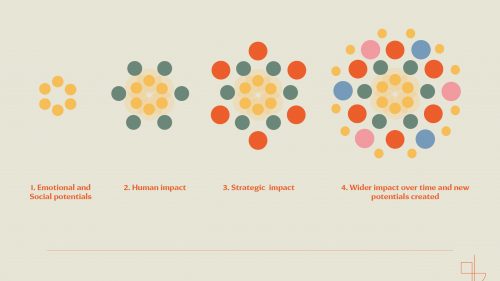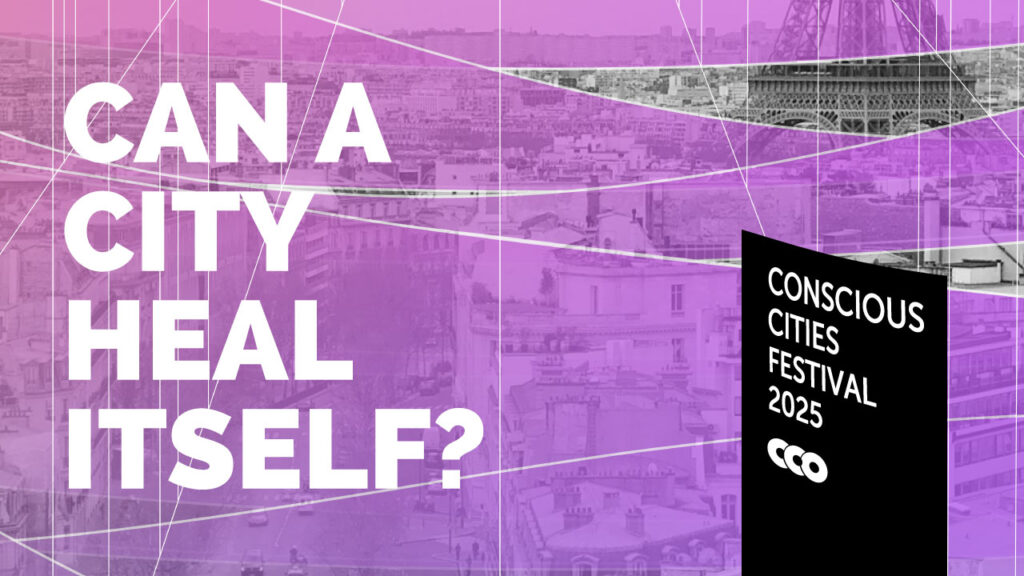Health and wellbeing, particularly in high-pressure environments, present complex challenges that architects are increasingly called to address. From first-responder stations and healthcare units to emergency camps and competitive sports facilities, many spaces support individuals facing extreme physical and psychological demands. The cumulative toll of high-pressure contexts can significantly impact mental, emotional, and physical health, leading to heightened stress, burnout, and even conflict. However, the design of the spaces where these happen could play a crucial role in preserving people’s long-term wellbeing by investigating and addressing the specific needs of those involved.
This article explores the relationship between human resilience and architectural space within high-pressure environments. By focusing on the specific case of a firefighters’ station, the unique challenges encountered by individuals in this demanding role are examined, alongside research-driven insights that can be translated into practical and supportive spaces. The aim is to demonstrate how spatial design can enhance resilience in high-pressure settings, particularly by incorporating spaces that promote relaxation and restoration.
1. Understanding High-Pressure Environments
High-pressure environments are situations that demand exceptional mental and physical resilience, where the stakes are high, and the consequences of failure can be significant. Beyond the immediate physical risks inherent in roles like firefighting, the stress associated with these contexts alone can dysregulate the body’s neurophysiology, elevating cortisol levels and affecting physical health1. Elevated cortisol contributes to increased pain sensitivity, impaired immune and organ functioning, and disrupted sleep1. Over time, chronic stress and inadequate sleep have been shown to strongly correlate with burnout and depression2. In more severe cases, single or multiple traumatic events within these environments may lead to mental health disorders, including post-traumatic stress disorder (PTSD).
Professionals in high-pressure roles, such as healthcare personnel, emergency management teams, and competitive performers, prepare themselves to face these extreme demands through rigorous mental and physical training. Preparation often includes cultivating a positive mindset, setting realistic expectations, and mentally rehearsing the actions necessary for success. Physical preparation is equally vital and often involves physical fitness, enhancing reaction times, and increasing endurance. Leveraging the environment to further enhance personal efficacy and well-being in these situations is a strategic choice, as it can provide tangible benefits.
In many fields, high-pressure environments also require a high degree of coordination among roles, while efficient communication is essential to maintaining safety and performance. Additionally, spaces designed for high-pressure situations, from long-distance sailing vessels to emergency response centers, require precision in their layout and efficiency in their structure, with every piece of equipment thoughtfully placed to reduce cognitive load and allow the professionals to focus on the task at hand.
During or after stressful events, healthy coping mechanisms can help manage the intense emotions that can arise in high-pressure situations3. Research indicates that when individuals, particularly first responders, actively engage in positive coping strategies, they are better able to process their experiences and mitigate the long-term effects of stress than if they don’t4. A study focused on the fire service5 highlighted several effective introspective coping strategies, such as reflecting on the meaning of life after a critical incident or fully experiencing the associated emotions. Social support, whether through talking with colleagues or helping others, also plays a vital role in emotional recovery.
2. Key Design Factors for High-Pressure Environments
Drawing inspiration from successful interventions like the “recharge rooms” designed by Studio Elsewhere—which have shown a 60% reduction in stress after just 15 minutes of use by healthcare workers6—architectural design proves to be a powerful tool in promoting resilience in high-pressure environments.
In such settings, individuals rely on their surroundings to support ongoing preparation, facilitate efficient action, and provide opportunities for both social connection and individual restoration afterward. Several key factors seem paramount: prioritizing safety and functionality, enabling adaptability, fostering teamwork, providing opportunities for restoration, and promoting positive emotions.
Safety and functionality are essential for carrying out tasks effectively under pressure, reducing errors, and ensuring the wellbeing of those involved. A well-organized, intuitive space allows professionals to focus on their work, reducing cognitive strain. Flexible design features can enable spaces to transform according to the dynamic needs of environments, like emergency rooms or operations centers. Additionally, fostering teamwork through thoughtfully designed social interaction spaces and layouts that encourage easy communication is vital, as collaboration is crucial in high-pressure settings, and strong social bonds enhance psychological resilience.
Serene, private spaces for mindful recovery are often missing in high-pressure environments, yet they can be transformative for long-term wellbeing and team success. Spaces of restoration serve as external tools for managing stress, complementing individuals’ internal and social coping strategies. The opportunity to retreat to a quiet, calming space with sensory connections to nature—much like a meditation room or garden—enables people to reconnect with themselves, process intense emotions, or self-soothe, allowing for mental recharging before returning to their duties or other needs. Providing such environments is incredibly supportive for wellbeing, as they effectively facilitate mental and emotional recovery. Moreover, promoting positive emotions is crucial for mental resilience7, as positive feelings counteract negative ones, boost cognitive flexibility, and strengthen internal resilience. A thoughtful layout, combined with carefully selected lighting, materials, artistic decor, and natural elements, can create environments that evoke calm, beauty, and joy. Notably, the integration of nature alone encourages positive emotional responses, likely due to humanity’s evolutionary connection to natural environments8. By incorporating these factors, architecture can significantly contribute to sustaining long-term well-being in high-pressure environments.
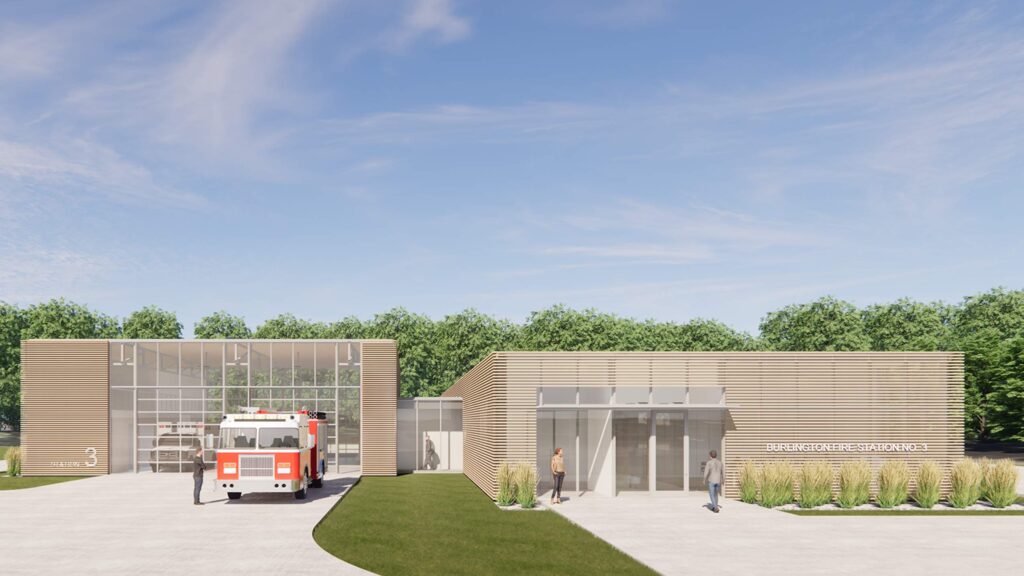
3. Case Study: The Burlington Fire Station
This case study presents a theoretical design proposal for the Burlington Fire Station (Iowa), undertaken for OPN Architects, who in 2023 received the Biophilic Design Award for the Marion Fire Station. This project provided an opportunity to explore how design could support the resilience of firefighters by creating an environment that enhances both their physical and mental health during standby time at the station, ultimately improving their overall quality of life.
As a research-informed consultant, I was specifically tasked with reviewing the conceptual design of the sleeping quarters and assessing how the new station’s architecture was positively impacting firefighter health. My goal was also to provide further insights on how the building could support the psychological resilience of its users through design improvements, particularly in the sleep quarters.
Foundations for Design
Before delving into the design process, it was essential to understand the unique psychological challenges faced by fire service members. In addition to reviewing recent publications on the topic, I engaged in conversations with firefighters to gain firsthand insights into their experiences. Research indicates that this profession has one of the highest rates of burnout and mental health issues, including PTSD, affecting approximately 20% of fire service members9. Long shifts—often exceeding 24 hours—combined with the high-stress nature of emergency response work, contribute to significant sleep disorders and overall mental health decline10. Given the importance of sleep quality in wellbeing, the creation of optimal rest environments became a central focus of the project. Research has demonstrated that firefighters who obtain adequate sleep during overnight shifts are at lower risk of burnout and emotional exhaustion11. Understanding the broader context of the fire service was also crucial, particularly in light of the current staffing crisis. A recent report revealed that mandatory overtime and work-related stress are primary reasons why 40% of American firefighters are considering leaving the profession12. While firefighting was once one of the most sought-after jobs in the country, cultural shifts towards prioritizing work-life balance and mental health have contributed to a decline in interest in this career. Could improved facilities designed with these priorities in mind play a role in reversing this trend and retaining dedicated professionals in the fire service?

Recent years have seen a notable shift towards fostering group and peer support as tools for emotional resilience within the fire service, and some of my early conversations with firefighters confirmed the effectiveness of these practices. Mindfulness, a valuable tool for emotional self-regulation13, was also a focus of my inquiry. Despite increased awareness, research shows that many firefighters still lack the specific training and ongoing support needed to cope effectively with their experiences4. The absence of robust strategies for integrating traumatic experiences further exacerbates the severity of mental health challenges in this group.
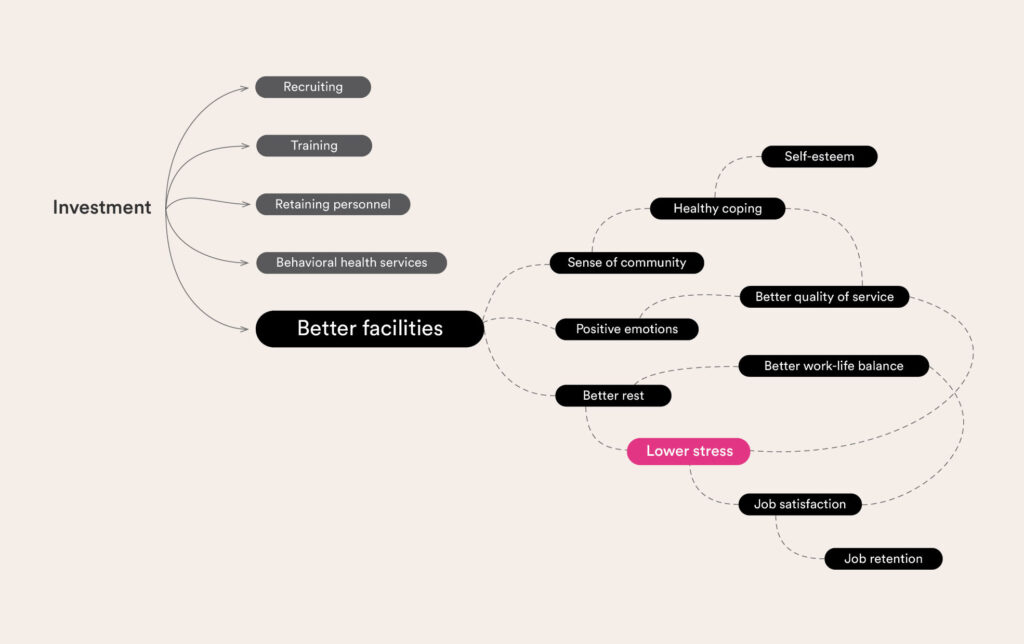
The existing Burlington Fire Station, like many others, is not adequately designed to facilitate the work of these dedicated professionals. Concrete block walls, sterile interiors, and a lack of private, restful spaces fail to support the necessary emotional and physical recovery during standby periods. The current building features a common room for group or solitary activities, but private spaces are entirely lacking, and the sleeping quarters are dark, shared rooms with bare walls—functional but uninspiring. This realization formed the basis of the design challenge: to create a new station that not only serves as an operational hub but also provides private spaces that can be used as personal sanctuaries for rest, recovery, and mental resilience, while significantly improving sleep conditions. The original concept by OPN Architects already included several well-placed single-person rooms with ground access to the exterior, ample glazing for natural light and views of greenery, and wood surfaces and accents, as well as other interior and exterior common spaces for social connection.
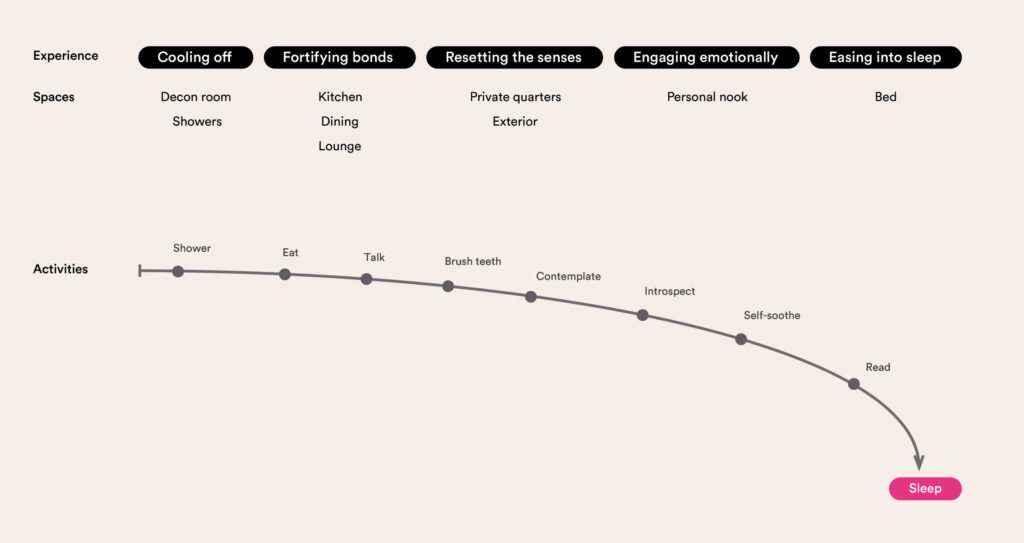
Design Insights
A key concept that emerged from this study is the recognition that “going to sleep” in this high-pressure environment is not a single event, but a process that unfolds in stages. The design centered on three interconnected goals that chronologically guide this process: resetting the senses, engaging emotionally, and easing into sleep.
- Resetting the Senses: This experience is focused on transitioning from the external demands of the day to a state of calm. By incorporating elements such as natural or low-intensity warm lighting and biophilic design principles—drawing on natural materials and views of greenery—the environment can be crafted crafted to ease the mind and body into relaxation.
- Engaging Emotionally: Once the mind and body have been calmed, the next experience involves engaging on an emotional level to refill the mind with positive, meaningful content. To achieve this, the design suggests incorporating several sliding panels within each room that can be fully personalized by the regular occupants (up to three individuals rotating shifts). This customization allows firefighters to curate a space with personal mementos, such as family photos, enabling them to unwind in a personalized environment and fostering a connection to meaningful elements before sleep.
- Easing into Sleep: The final phase focuses on achieving optimal restful sleep within the bedroom environment. Key considerations include controlling light exposure, minimizing noise, and ensuring adequate ventilation.
The architects have shown enthusiasm for expanding the application of these ideas throughout the fire station, beyond just the design of the bedrooms. Notably, they are exploring the incorporation of biophilic elements into the showers and decontamination spaces, which are the first areas personnel encounter upon returning to the station. This approach aims to treat every step—from arrival at the station to the process of going to sleep—as an opportunity to create restorative moments, further supporting the overall wellbeing of the firefighters in all aspects of their routine.
To ensure the design aligns with the specific needs of firefighters, a follow-up survey and interview process is planned. This engagement will refine and evolve the design based on direct user feedback. The survey aims to capture key experiences, including stress levels, the impact of work-related stress on other aspects of life, and the activities engaged in during standby time.
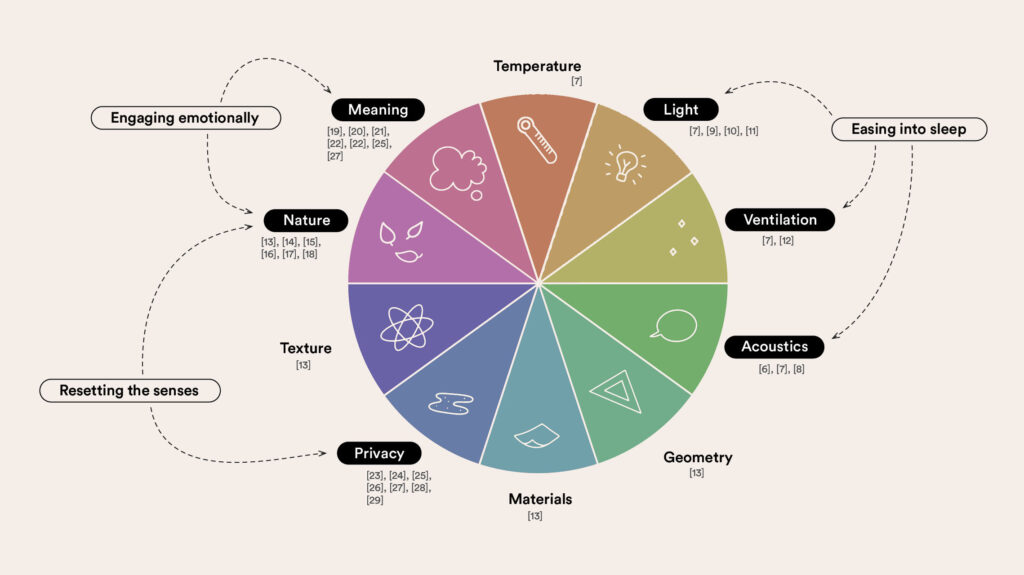
Science Translation
The design insights in this project were supported by a thorough investigation of previous scientific literature. Below is a summary of key findings from studies on light, acoustics, ventilation, connection to nature, and meaning, and how these informed the study design recommendations.
Light
- Daytime exposure to natural light is essential for regulating circadian rhythms, enhancing mood, and promoting alertness at the workplace14.
- Conversely, exposure to high-intensity, cool artificial light during nighttime can disrupt melatonin production, adversely affecting sleep quality15.
- In environments like fire stations, where rapid transitions from sleep to wakefulness are critical, the use of high-intensity, cool artificial light (above 5000 Kelvin) can be strategically employed to quickly boost alertness15.
- Pre-bedtime exposure to low-intensity, warm light (under 3000 Kelvin) minimizes disruptions to melatonin production and supports circadian rhythm stability, while total darkness remains optimal for achieving restorative sleep15.
- Individual sensitivity to nighttime light exposure varies, with some individuals more prone to light-induced sleep disturbances. However, research indicates that light levels below 5 lux generally have minimal impact on sleep for most individuals16.
Achieving total darkness in the space through thick curtains or other light-control mechanisms was recommended, while the positive mood impact of large windows during the daytime was highlighted. Additionally, a ceiling cove with dual indirect lighting was suggested: with one circuit for high-intensity cool light to support wakefulness and another for low-intensity warm light, to be used at the occupant’s discretion.
Acoustics
- Noise is a primary factor in sleep disruption among shift workers, with intermittent sounds above 55 decibels causing awakenings and impairing daytime performance17.
- Maintaining noise levels below 30 decibels is crucial for supporting deeper, more restorative sleep stages, leading to better overall sleep quality, improved next-day functioning, and a reduced reliance on sleep aids17,18.
- Contrary to popular belief, research indicates that white noise can have a negative impact on sleep, challenging the notion that it is a universally beneficial sleep aid19.
Optimal acoustics was emphasized as paramount in the sleeping rooms. This study recommended rotating the bed 90 degrees to create an acoustic buffer that doubles as a changing room and personal storage area, positioned between the circulation corridors and the sleep areas. Additionally, it was recommended to use thick sound-absorbing curtains and to revise the floor and wall materials in these spaces to further enhance soundproofing.
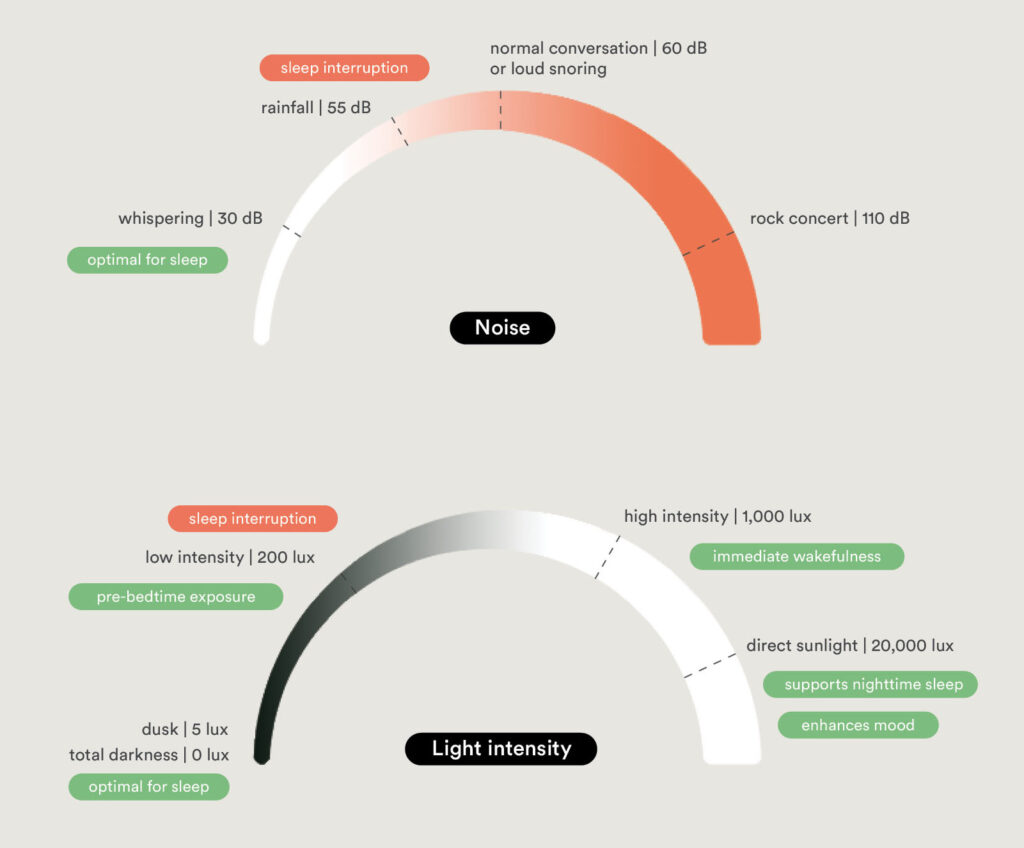
Ventilation
- Adequate ventilation plays a critical role in enhancing sleep quality, with improved airflow directly linked to higher sleep efficiency, deeper sleep, and fewer awakenings20.
- Studies show that constant airflow and maintaining CO2 levels below 750 ppm (parts per million) are essential for optimal sleep. Participants in controlled experiments reported better sleep patterns and felt more refreshed when CO2 concentrations were kept low18,20.
- Conversely, CO2 levels above 2,600 ppm have been shown to impair sleep quality and negatively impact next-day cognitive functions20.
- Effective ventilation systems must not only mitigate CO2 buildup but also control other indoor air pollutants that can affect overall health.
The study assumed a high-quality ventilation system capable of maintaining CO2 levels below 750 ppm but additionally recommended sizing the system to ensure the air in the room is exchanged at a rate of 1.9 times the room’s air volume. It also suggested the inclusion of an operable window to allow personal control over ventilation and temperature.
Nature
- Exposure to natural settings or elements, such as views of greenery, natural materials, and daylight, promotes mental clarity, enhances mood, and supports emotional resilience21.
- Nature-inspired spaces encourage a sense of calm and relaxation, which can significantly lower stress levels, especially in high-stress professions like firefighting22.
- Incorporating biophilic elements into work environments, such as gardens, indoor plants, natural textures, and water features, has been linked to improved cognitive function, better mood, and increased satisfaction with the workspace8.
- Studies suggest that biophilic environments not only provide restorative benefits but also contribute to higher productivity, better attention restoration, and overall improved mental health23.
The original concept design already incorporated numerous natural elements and views of greenery. It was further suggested to extend these features into the showers and bathrooms, and to add water features around the building. The covered atrium in front of the sleeping rooms was viewed as an opportunity for outdoor time, with the inclusion of planters and seating elements for each individual room recommended.
Meaning
- The use of materiality and form in architecture plays a crucial role in how spaces are perceived and felt. Materials that evoke warmth, softness, and movement can create a welcoming atmosphere, while cold, hard materials might convey emotional distance and sterility24.
- Meaning in design also involves crafting environments that resonate with individuals on a personal level25. This connection can be achieved through familiar elements that evoke comfort or through awe-inspiring features that create a strong sense of place.
- Meaningful environments support self-esteem and a sense of community by aligning physical qualities with the psychological needs of the occupants26. When a space feels “human” in its design, it helps individuals feel valued and understood within that environment.
- Individuals unconsciously attribute the qualities of buildings to the institutions that promote them27,28. The physical design of a space can significantly influence perceptions of the organization or community it represents.
The study emphasized the importance of personalization in the individual rooms, recommending the inclusion of personalizable sliding panels and several modifications to enhance a human scale. These changes included rotating the bed to face the personalization walls, adding textured curtains between the changing areas and sleeping areas, as well as between the beds and the glazing wall. It also proposed the inclusion of a warm lighting circuit and operable elements for light and ventilation. The study further suggested applying these considerations to the large corridor immediately outside the sleeping rooms and the decontamination areas, to avoid creating sterile environments that would otherwise undermine the sense of place and community.
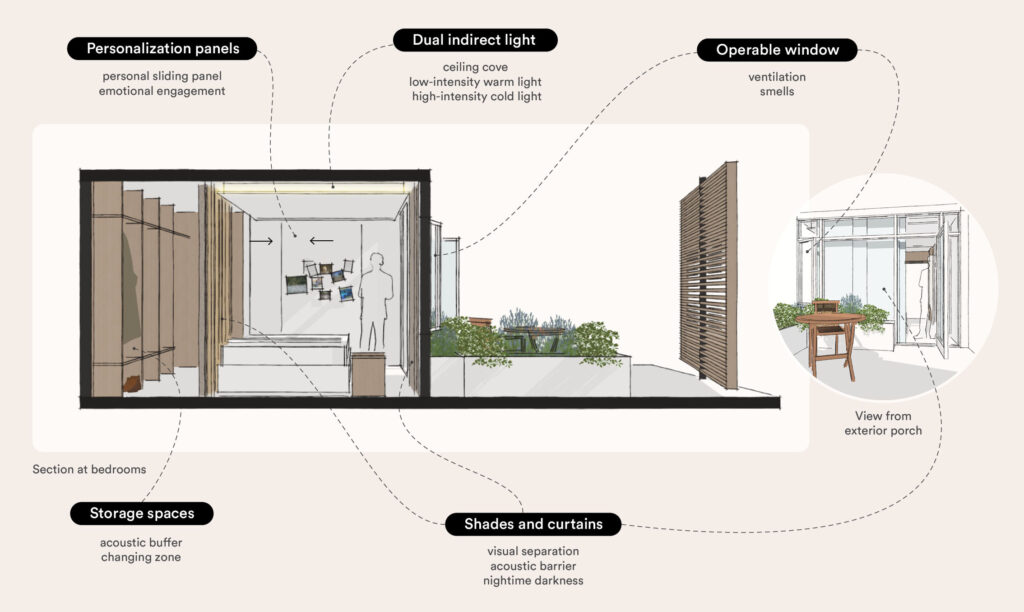
4. Conclusion: A Future-Focused Approach to Empowering Wellbeing
While this case study on the Burlington Fire Station remains theoretical, it offers valuable insights into designing for health and wellbeing, particularly in high-pressure environments. It underscores the importance of rigor in the design process, the need for multidisciplinary investigations into people’s needs and experiences, and the thoughtful consideration of spatial qualities that create supportive environments.
Key takeaways from this study include:
- Holistic Wellbeing: To consider a comprehensive health approach that integrates physical, mental, emotional, and social needs.
- Evidence-Based Design: To ground design decisions on established human psychology models supported by empirical research.
- Personalized Restorative Spaces: To prioritize creating customizable, private, restful environments within a high-pressure setting to promote moments of recovery in emotionally-supportive atmospheres.
- Stakeholder-Centered Process: To integrate ongoing user feedback to ensure the design remains responsive to real needs.
This study exemplifies how design can be enriched through insights from both science and community engagement to create spaces that support individuals in high-pressure contexts. It also sets a new benchmark for caring for firefighters, demonstrating how architectural design can enhance their health and resilience. Looking to the future, designers and communities bear a shared responsibility to prioritize the wellbeing of those in high-pressure environments and to expand the possibilities for physical and emotional care, even in the most challenging settings.
References
1 Antoni, M. H. (1987). Neuroendocrine influences in psychoimmunology and neoplasia: A review. Psychology & Health, 1(1), 3–24. https://doi.org/10.1080/08870448708400311
2 Huang, G., Lee, T.-Y., Banda, K. J., Pien, L.-C., Jen, H.-J., Chen, R., Liu, D., Hsiao, S.-T. S., & Chou, K.-R. (n.d.). Prevalence of sleep disorders among first responders for medical emergencies: A meta-analysis. Journal of Global Health, 12, 04092. https://doi.org/10.7189/jogh.12.04092
3 Stallman, H. M. (2020). Health theory of coping. Australian Psychologist, 55(4), 295–306. https://doi.org/10.1111/ap.12465
4 Díaz-Tamayo, A. M., Escobar-Morantes, J. R., & García-Perdomo, H. A. (2022). Coping strategies for exposure to trauma situations in first responders: A systematic review. Prehospital and Disaster Medicine, 37(6), 810–818. https://doi.org/10.1017/S1049023X22001479
5 Beaton, R., Murphy, S., Johnson, C., Pike, K., & Corneil, W. (1999). Coping responses and posttraumatic stress symptomatology in urban fire service personnel. Journal of Traumatic Stress, 12(2), 293–308. https://doi.org/10.1023/A:1024776509667
6 Putrino, D., Ripp, J., Herrera, J. E., Cortes, M., Kellner, C., Rizk, D., & Dams-O’Connor, K. (2020). Multisensory, nature-inspired recharge rooms yield short-term reductions in perceived stress among frontline healthcare workers. Frontiers in Psychology, 11. https://doi.org/10.3389/fpsyg.2020.560833
7 Fredrickson, B. L. (2000). Cultivating positive emotions to optimize health and well-being. Prevention & Treatment, 3(1), No Pagination Specified-No Pagination Specified. https://doi.org/10.1037/1522-3736.3.1.31a
8 Kellert, S. R. (2005). Building for life: Understanding and designing the human-nature connection. Washington, DC: Island Press.
9 Oliveira, J., Aires Dias, J., Duarte, I. C., Caldeira, S., Marques, A. R., Rodrigues, V., Redondo, J., & Castelo-Branco, M. (2023). Mental health and post-traumatic stress disorder in firefighters: An integrated analysis from an action research study. Frontiers in Psychology, 14, 1259388. https://doi.org/10.3389/fpsyg.2023.1259388
10 Smith, T. D., DeJoy, D. M., Dyal, M.-A. (Aimee), & Huang, G. (2019). Impact of work pressure, work stress and work–family conflict on firefighter burnout. Archives of Environmental & Occupational Health, 74(4), 215–222. https://doi.org/10.1080/19338244.2017.1395789
11 Wolkow, A. P., Barger, L. K., O’Brien, C. S., Sullivan, J. P., Qadri, S., Lockley, S. W., Czeisler, C. A., & Rajaratnam, S. M. W. (2019). Associations between sleep disturbances, mental health outcomes and burnout in firefighters, and the mediating role of sleep during overnight work: A cross-sectional study. Journal of Sleep Research, 28(6), e12869. https://doi.org/10.1111/jsr.12869
12 What Firefighters Want in 2023. (2022). FireRescue1.
13 Roemer, L., Williston, S. K., & Rollins, L. G. (2015). Mindfulness and emotion regulation. Current Opinion in Psychology, 3, 52–57. https://doi.org/10.1016/j.copsyc.2015.02.006
14 Harb, F., Hidalgo, M. P., & Martau, B. (2015). Lack of exposure to natural light in the workspace is associated with physiological, sleep and depressive symptoms. Chronobiology International, 32(3), 368–375. https://doi.org/10.3109/07420528.2014.982757
15 Xiao, H., Cai, H., & Li, X. (2021). Non-visual effects of indoor light environment on humans: A review✰. Physiology & Behavior, 228, 113195. https://doi.org/10.1016/j.physbeh.2020.113195
16 Tähkämö, L., Partonen, T., & Pesonen, A.-K. (2019). Systematic review of light exposure impact on human circadian rhythm. Chronobiology International, 36(2), 151–170. https://doi.org/10.1080/07420528.2018.1527773
17 Muzet, A. (2007). Environmental noise, sleep and health. Sleep Medicine Reviews, 11(2), 135–142. https://doi.org/10.1016/j.smrv.2006.09.001
18 Caddick, Z. A., Gregory, K., Arsintescu, L., & Flynn-Evans, E. E. (2018). A review of the environmental parameters necessary for an optimal sleep environment. Building and Environment, 132, 11–20. https://doi.org/10.1016/j.buildenv.2018.01.020
19 Riedy, S. M., Smith, M. G., Rocha, S., & Basner, M. (2021). Noise as a sleep aid: A systematic review. Sleep Medicine Reviews, 55, 101385. https://doi.org/10.1016/j.smrv.2020.101385
20 Sekhar, C., Akimoto, M., Fan, X., Bivolarova, M., Liao, C., Lan, L., & Wargocki, P. (2020). Bedroom ventilation: Review of existing evidence and current standards. Building and Environment, 184, 107229. https://doi.org/10.1016/j.buildenv.2020.107229
21 Kellert, S. R., & Wilson, E. O. (1995). The Biophilia Hypothesis. Island Press.
22 Bell, S. L., Foley, R., Houghton, F., Maddrell, A., & Williams, A. M. (2018). From therapeutic landscapes to healthy spaces, places and practices: A scoping review. Social Science & Medicine, 196, 123–130. https://doi.org/10.1016/j.socscimed.2017.11.035
23 Kaplan, S. (1995). The restorative benefits of nature: Toward an integrative framework. Journal of Environmental Psychology, 15(3), 169–182. https://doi.org/10.1016/0272-4944(95)90001-2
24 Mallgrave, H. F. (2013). Architecture and Embodiment: The Implications of the New Sciences and Humanities for Design. Routledge.
25 Hashem, H., Yazdanfar, S. A., Heidari, A. A., & Nazgol, B. (2013). Between sense and attachment: Comparing the concepts of place in architectural studies. Geografia: Malaysian Journal of Society & Space, 9(1).
26 Scannell, L., & Gifford, R. (2017). Place attachment enhances psychological need satisfaction. Environment and Behavior, 49(4), 359–389. https://doi.org/10.1177/0013916516637648
27 Rajeswaran, B., & Kesavaperumal, T. (2018). Perceived institutional campus image and its entrance edifice. Open House International, 43(3), 52–58. https://doi.org/10.1108/OHI-03-2018-B0007
28 Ha, J., & Jang, S. (Shawn). (2012). The effects of dining atmospherics on behavioral intentions through quality perception. Journal of Services Marketing, 26(3), 204–215. https://doi.org/10.1108/08876041211224004





